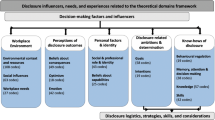Abstract
Research shows that LGBTQ workers make strategic decisions about whether to disclose their sexual and gender identities to their colleagues as they assess potential costs and benefits. The present study sought to extend this literature by examining how they plan their identity disclosure in future workplace interactions and why they may diverge from their initial intentions. The analysis used longitudinal data from in-depth interviews, in which young LGBTQ workers reported disclosure intentions and their outcomes two years later. Participants often expressed intentions to disclose their LGBTQ identities while emphasizing the importance of identity disclosure for self-authenticity and the LGBTQ community’s visibility. Sometime over the course of the study, however, a substantial number of participants did not carry out their intentions because of unanticipated workplace constraints such as a lack of opportunities for personal conversations, an expectation for professionalism, and an absence of LGBTQ colleagues. However, participants who diverged from their initial disclosure intentions maintained an identity as an open LGBTQ person by emphasizing their willingness for disclosure.
Similar content being viewed by others
Availability of Data and Material
Because of the sensitive nature of the qualitative data from in-depth interviews, the data will not be shared to protect participants’ confidentiality.
Code Availability
Not applicable.
Notes
These studies reference to each other and represent an integrated body of the literature, but individual studies vary with regard to what aspects of disclosure process they concentrate on and which subgroups of the LGBTQ population they target.
We use the phrase, LGBTQ to describe the participants’ sexual and gender identities although some participants used other labels such as pansexual and flexible. We do so for two reasons. First, it is a commonly used phrase in academia, the general public, and the media, which includes anyone who is non-heterosexual and non-cisgender. Second, participants who identified as pansexual and flexible used the phrase LGBTQ (or similar phrases such as LGBT) while implying that they were part of the population.
References
Abboud, S., & Flores, D. D. (2023). A developmental model of the sexual minority closet: Implications for Arab immigrant sexual minorities and parent-LGBTQ child sex communication [Commentary]. Archives of Sex Behavior, 52(5), 1897–1902.
Arena, D. F., & Jones, K. P. (2017). To “B” or not to “B”: Assessing the disclosure dilemma of bisexual individuals at work. Sexuality Research & Social Policy, 103, 86–98.
Armstrong, E. A. (2002). Forging gay identities: Organizing sexuality in San Francisco, 1950–1994. University of Chicago Press.
Baker, P. (2005). Public discourses of gay men. Routledge.
Beagan, B. L., Sibbald, K. R., Bizzeth, S. R., & Pride, T. M. (2023). Factors influencing LGBTQ+ disclosure decision-making by Canadian health professionals: A qualitative study. PLoS ONE, 18(2), e0280558–e0280558. https://doi.org/10.1371/journal.pone.0280558
Benozzo, A., Pizzorno, M. C., Bell, H., & Koro-Ljungberg, M. (2015). Coming out, but into what? Problematizing discursive variations of revealing the gay self in the workplace. Gender, Work and Organization, 22(3), 292–306. https://doi.org/10.1111/gwao.12081
Brumbaugh-Johnson, S. M., & Hull, K. E. (2019). Coming out as transgender: Navigating the social implications of a transgender identity. Journal of Homosexuality, 66(8), 1148–1177.
Cass, V. C. (1979). Homosexual identity formation: A theoretical model. Journal of Homosexuality, 4(3), 219–235.
Cech, E. A., & Waidzunas, T. J. (2011). Navigating the heteronormativity of engineering: The experiences of lesbian, gay, and bisexual students. Engineering Studies, 3, 1–24.
Cohler, B. J., & Hostetler, A. (2003). Linking life course and life story: Social change and the narrative study of lives over time. In J. T. Mortimer & M. J. Shanahan (Eds.), Handbook of the Life course (pp. 555–576). Kluwer.
Coleman, E. L. I. (1982). Developmental stages of the coming-out process. Career Development Quarterly, 25(4), 469–482.
Colgan, F., Creegan, C., McKearney, A., & Wright, T. (2008). Lesbian workers: Personal strategies amid changing organisational responses to “sexual minorities” in UK workplaces. Journal of Lesbian Studies, 12(1), 31–45.
Connell, C. (2015). School’s out: Gay and lesbian teachers in the classroom. Berkeley: University of California Press.
Deterding, N. M., & Waters, M. C. (2021). Flexible coding of in-depth interviews: A twenty-first-century approach. Sociological Methods & Research, 50(2), 708–739. https://doi.org/10.1177/0049124118799377
Doyle, D. M., & Barreto, M. (2023). Toward a more relational model of sexual minority identity concealment [Commentary]. Archives of Sexual Behavior, 52(5), 1911–1916.
Doyle, D. M., Begeny, C. T., Barreto, M., & Morton, T. A. (2021). Identity-related factors protect well-being against stigma for transgender and gender non-conforming people. Archives of Sexual Behavior, 50(7), 3191–3200.
Duggan, L. (2002). The new homonormativity: The sexual politics of neoliberalism. In R. Castronovo & D. D. Nelson (Eds.), Materializing democracy: Toward a revitalized cultural politics (pp. 175–194). Duke University Press.
Einarsdóttir, A., Hoel, H., & Lewis, D. (2016). Fitting the bill? (Dis) embodied disclosure of sexual identities in the workplace. Work, Employment and Society, 30(3), 489–505.
Ewick, P., & Silbey, S. S. (1995). Subversive stories and hegemonic tales: Toward a sociology of narrative. Law and Society Review, 29(2), 197–226.
Ezzy, D. (1997). Subjectivity and the labour process: Conceptualising “good work.” Sociology, 31(3), 427–444. https://doi.org/10.1177/0038038597031003004
Fine, G. A. (1995). Public narration and group culture: Discerning discourse in social movements. In H. Johnston & B. Klandermans (Eds.), Social movements and culture (pp. 127–143). University of Minnesota Press.
Fletcher, L., & Everly, B. A. (2021). Perceived lesbian, gay, bisexual, and transgender (LGBT) supportive practices and the life satisfaction of LGBT employees: The roles of disclosure, authenticity at work, and identity centrality. Journal of Occupational and Organizational Psychology, 94(3), 485–508.
Follmer, K. B., Sabat, I. E., & Siuta, R. L. (2020). Disclosure of stigmatized identities at work: An interdisciplinary review and agenda for future research. Journal of Organizational Behavior, 41(2), 169–184.
Fric, K. (2019). How does being out at work relate to discrimination and unemployment of gays and lesbians? Theory into Practice, 53, 14. https://doi.org/10.1186/s12651-019-0264-1
Ghaziani, A. (2011). Post-gay collective identity construction. Social Problems, 58(1), 99–125. https://doi.org/10.1525/sp.2011.58.1.99
Guittar, N. A., & Rayburn, R. L. (2016). Coming out: The career management of one’s sexuality. Sexuality & Culture, 20(2), 336–357. https://doi.org/10.1007/s12119-015-9325-y
Holman, E. G., Ogolsky, B. G., & Oswald, R. F. (2022). Concealment of a sexual minority identity in the workplace: The role of workplace climate and identity centrality. Journal of Homosexuality, 69(9), 1467–1484.
Kade, T. (2021). “Hey, by the way, I’m transgender”: Transgender disclosures as coming out stories in social contexts among trans men. Socius, 7. https://doi.org/10.1177/23780231211039389
Kanter, R. M. (1977). Men and women of the corporation. Basic Books.
Kerckhoff, A. C. (2003). From student to worker. In J. T. Mortimer & M. J. Shanahan (Eds.), Handbook of the life course (pp. 251–267). Springer.
LaPointe, K. (2010). Narrating career, positioning identity: Career identity as a narrative practice. Journal of Vocational Behavior, 77(1), 1–9.
Le Forestier, J. M., Page-Gould, E., & Chasteen, A. L. (2022). Concealment stigma: The social costs of concealing. Journal of Experimental Social Psychology, 101, 104340.
Mallett, O., & Wapshott, R. (2015). Making sense of self-employment in late career: Understanding the identity work of olderpreneurs. Work, Employment and Society, 29(2), 250–266.
Mortimer, J. T., Zimmer-Gembeck, M. J., Shanahan, M. J., & Holmes, M. (2002). The process of occupational decision making: Patterns during the transition to adulthood. Journal of Vocational Behavior, 61(3), 439–465.
Orne, J. (2013). Queers in the line of fire: Goffman’s stigma revisited. Sociological Quarterly, 54(2), 229–253. https://doi.org/10.1111/tsq.12001
Pachankis, J. E., & Jackson, S. D. (2023). A developmental model of the sexual minority closet: Structural sensitization, psychological adaptations, and post-closet growth. Archives of Sexual Behavior, 52(5), 1869–1895.
Patton, L. D. (2011). Perspectives on identity, disclosure, and the campus environment among African American gay and bisexual men at one historically Black college. Journal of College Student Development, 52(1), 77–100. https://doi.org/10.1353/csd.2011.0001
Ragins, B. R. (2008). Disclosure disconnects: Antecedents and consequences of disclosing invisible stigmas across life domains. Academy of Management Review, 33(1), 194–215.
Ragins, B. R., & Cornwell, J. M. (2001). Pink triangles: Antecedents and consequences of perceived workplace discrimination against gay and lesbian employees. Journal of Applied Psychology, 86(6), 1244–1261.
Ragins, B. R., Cornwell, J. M., & Miller, J. S. (2003). Heterosexism in the workplace: Do race and gender matter? Group & Organization Management, 28(1), 45–74. https://doi.org/10.1177/1059601102250018
Rasmussen, M. L. (2004). The problem of coming out. Lawrence Erlbaum.
Rumens, N., & Kerfoot, D. (2009). Gay men at work: (Re)constructing the self as professional. Human Relations, 62(5), 763–786.
Schneider, B. E. (1986). Coming out at work: Bridging the private/public gap. Work and Occupations, 13(4), 463–487.
Schrimshaw, E. W., Downing, M. J., & Cohn, D. J. (2018). Reasons for non-disclosure of sexual orientation among behaviorally bisexual men: Non-disclosure as stigma management. Archives of Sexual Behavior, 47(1), 219–233.
Scott, W. R., & Davis, G. F. (2015). Organizations and organizing: Rational, natural and open systems perspectives. Routledge.
Seidman, S. (2002). Beyond the closet: The transformation of gay and lesbian life. London: Routledge.
Ueno, K., Jackson, T. M., Ingram, R., Grace, J., & Šaras, E. D. (2020). Sexual minority young adults’ construction of workplace acceptance in the era of diversity and inclusion. Social Currents, 7(2), 91–108.
Ueno, K., Jackson, T. M., Šaras, E. D., Grace, J., D’Amours, J. V., & Nix, A. N. (2023). Sexuality discourses and LGBQ students’ interpretations of campus climate in the contemporary US. Journal of Homosexuality, 70(6), 1073–1097. https://doi.org/10.1080/00918369.2021.2013039
Ueno, K., Peña-Talamantes, A. E., Roach, T. A., Nix, A. N., & Ritter, L. J. (2018). Sexuality-free careers? Sexual minority young adults’ perceived lack of labor market disadvantages. Social Problems, 65(3), 305–322.
Ward, J., & Winstanley, D. (2005). Coming out at work: Performativity and the recognition and renegotiation of identity. Sociological Review, 53(3), 447–475.
Funding
No funding was received for conducting this study.
Author information
Authors and Affiliations
Corresponding author
Ethics declarations
Conflicts of Interest
The authors declare that they have no conflict of interest.
Ethical Approval
Approval was obtained from the Human Subject Committee of the authors’ institution.
Informed Consent
Informed consent was obtained from all individual participants in the study.
Additional information
Publisher's Note
Springer Nature remains neutral with regard to jurisdictional claims in published maps and institutional affiliations.
Rights and permissions
Springer Nature or its licensor (e.g. a society or other partner) holds exclusive rights to this article under a publishing agreement with the author(s) or other rightsholder(s); author self-archiving of the accepted manuscript version of this article is solely governed by the terms of such publishing agreement and applicable law.
About this article
Cite this article
Ueno, K., Dominguez, R., Bastow, S. et al. LGBTQ Young Adults’ Identity Disclosure in the Workplace: A Longitudinal Qualitative Analysis of Disclosure Intentions and Outcomes. Arch Sex Behav 53, 1327–1341 (2024). https://doi.org/10.1007/s10508-024-02807-7
Received:
Revised:
Accepted:
Published:
Issue Date:
DOI: https://doi.org/10.1007/s10508-024-02807-7




